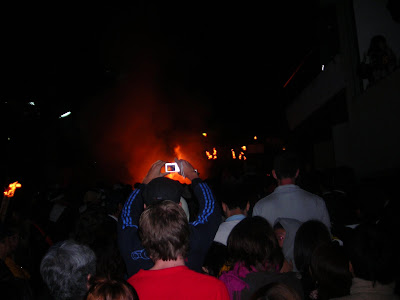
This past Tuesday I attended the annual Kuruma Fire Festival in the Kumura prefecture of Kyoto. Sorry to use an overused metaphor, but we were packed like sardines as we shuffled up to get a glimpse of the flames. I tried to take a picture from far away because everyone else seemed to be doing it, but the distant scene was obstructed by another photographer. I can see the fire in his camera, but not my own. The technology of digital cameras allows us to hold the camera above our heads and capture a scene we can not see ourselves when in a large crowd of tall foreigners. I feel as though this cheapens the experience--to watch something beautiful through the eye of a camera--but at least I can tell people I have been there, which is the point of tourism, right?

I tried with all my might to get a good-looking picture of this event. Here, men are crowded around one of the two mikoshi, a portable shrine. The colors were stripped away when I used flash, and movement was blurred when I didn't. Even if I did get a clear shot, there is still a curious filmmaker in the corner, interfering in my own anthropological work. What troubles we have to go through to avoid the interference of other spectators with cameras, while being interfering photographers ourselves.
What I learned from being a photographer who failed is that some experiences are just not meant to be captured on film. Margaret Mead is right in that visual anthropology enhances our cultural studies, but in the case of the Kumura Fire Festival, my CoolPix camera could never capture the smells or the cold or what it felt like to walk down an emptying street framed in flaming torches.




